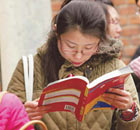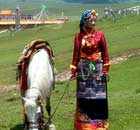Top Biz News
China's health safety net working, yet to be safer
(Xinhua)
Updated: 2010-03-08 13:14
 |
Large Medium Small |
BEIJING - For an average family in China's countryside, diagnosis of Leukemia means nothing but despair. Even if modern medicine could work miracle, the miracle is nonetheless unaffordable.
Yu Xiulian is a farmer of Molou village, the city of Zhongwei in the northwestern Ningxia Hui autonomous region. Her daughter was diagnosed of Leukemia in June, 2009.
Yu's family poured 60,000 yuan ($8,780) in less than one year in saving their daughter's life, a huge sum of money for a family of four living on monthly income of 1,600 yuan.
"I felt my heart frozen when the doctor told me about the cost of treatment," said she.
Fortunately, her daughter got medical assistance which covered 70 percent of the out-of-pocket payment (42,000 yuan). And 30 percent of the total cost (18,000 yuan) was reimbursed thanks to the new rural corporative medical care system (NCMS).
So at the end of the day, they paid 12,600 yuan. Yu said, "Without the medical assistance, I might have to give up my daughter's life."
|
||||
It is provided to financially challenged urban and rural residents who are afflicted by ten serious diseases, such as tumor, uremia and sever hepatic diseases.
According to Zhongwei's policy, the reimbursement rate is linked to the out-of-pocket fee for inpatient medical services.
If the one-year medical cost falls in the bracket of 30,000 to 50,000 yuan, the rate is 60 percent, 50,000 to 100,000 yuan bracket, 70 percent, and higher, 80 percent.
Those who need medical assistance need to file applications which are subject to approval by a board composed of civil affair officials, health experts, local legislators etc.
Medical assistance scheme is carried out across China, reimbursing patients' out-of-pocket fee for inpatient and outpatient medical services, relieving financial burdens of low income groups.
Specific policies may vary according to financial strengths of different localities.
Yang Lixiong, a Renmin University professor specialized in social security, said health security plays the most important role in making lives easier for low income groups.
"Otherwise, if one gets severe disease, an entire family could be dragged below poverty line," said Yang.












